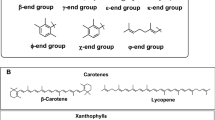Summary.
Using the hypericin and fringelite D photosensitized destruction of bilirubin together with fluorescence spectroscopy it was found that in contrast to fringelite D hypericin behaves as an effective photodynamic agent producing mainly singlet oxygen. This makes fringelite D and concomitantly the related stentorin and blepharismin pigments better suited for the photosensory transduction chain where, as shown recently, an initial proton expulsion reaction plays the fundamental role. Thus, in organisms using these photosensory pigments the production of deleterious oxygen species becomes diminished as compared to hypericin. In addition it was found that complexation with albumin further inhibits bilirubin destruction.
Similar content being viewed by others
Author information
Authors and Affiliations
Additional information
Received June 29, 2000. Accepted July 18, 2000
Rights and permissions
About this article
Cite this article
Immitzer, B., Falk, H. Fringelite D, a Model of the Protist Photosensory Pigments of the Stentorinand Blepharismin Types: The Hypericinand Fringelite D PhotosensitizedDestruction of Bilirubin. Monatshefte fuer Chemie 131, 1167–1171 (2000). https://doi.org/10.1007/s007060070024
Issue Date:
DOI: https://doi.org/10.1007/s007060070024




